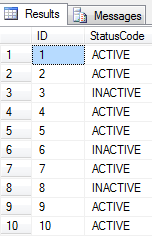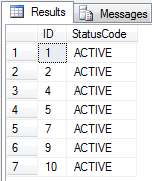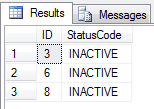In this article, we will be discussing about the OUTPUT clause in SQL Server, and how we can use it for creating data archiving mechanisms.
What is the OUTPUT Clause in SQL Server?
The OUTPUT Clause in T-SQL as described in the relevant MS Docs article, “returns information from, or expressions based on, each row affected by an INSERT, UPDATE, DELETE, or MERGE statement.”
Using the OUTPUT Clause in SQL Server for Data Archiving
The functionality provided by the OUTPUT clause is very powerful and can be used in many scenarios. One such a scenario is Data Archiving.
Consider the following example based on which there is a “CustomerData” table containing customer IDs and status codes indidicating whether a customer is Active or Inactive.
A data archiving scenario would be to archive all the customers having the status “INACTIVE”.
For this example I am going to use two tables called “CustomerData” and “CustomerArchive“.
OK, let’s see some code!
--Creates the schema
CREATE SCHEMA Test
GO
--Creates the data table for customers
CREATE TABLE Test.CustomerData
(
ID int IDENTITY(1,1) NOT NULL,
StatusCode VARCHAR(10) NOT NULL
);
GO
--Creates the data table for customers archive
CREATE TABLE Test.CustomerArchive
(
ID int NOT NULL,
StatusCode VARCHAR(10) NOT NULL
);
GO
--Populates data table with some sample data (Using Row Constructors)
INSERT INTO Test.CustomerData (StatusCode)
VALUES ('ACTIVE'),
('ACTIVE'),
('INACTIVE'),
('ACTIVE'),
('ACTIVE'),
('INACTIVE'),
('ACTIVE'),
('INACTIVE'),
('ACTIVE'),
('ACTIVE');
GO
Now, let’s check out the contents of the two tables:

CustomerArchive:
![]()
Now, let’s archive the CustomersData table using the OUTPUT clause in the below query and check the table contents again:
--Archive inactive customers and store the records in the "CustomerArchive" table DELETE FROM Test.CustomerData OUTPUT DELETED.* INTO Test.CustomerArchive WHERE StatusCode='INACTIVE'; GO
CustomerData:

CustomerArchive:

Discussion
As you can see from the above results, with just a single T-SQL statement, we managed to delete the desired data from the CustomerData table and also archive it into the CustomerArchive table.
The above scenario was just a simple example on how data archiving can be performed using the OUTPUT clause in SQL Server. You can build more complex data archiving logic using the OUTPUT clause as you can also use the INSERTED keyword and perform multiple joins in the query which uses the OUTPUT clause.
Note: Always be careful when deleting data and always keep backups of your data.
Learn More Tips like this – Enroll to the Course!
Check our online course titled “Essential SQL Server Development Tips for SQL Developers” (special limited-time discount included in link).
Sharpen your SQL Server database programming skills via a large set of tips on T-SQL and database development techniques. The course, among other, features over than 30 live demonstrations!

Upgrade your Tech Skills – Learn all about Azure SQL Database
Enroll to our online course on Udemy titled “Introduction to Azure SQL Database for Beginners” and get lifetime access to high-quality lessons and hands-on guides about all aspects of Azure SQL Database.

Featured Online Courses:
- Introduction to Azure SQL Database for Beginners
- SQL Server 2019: What’s New – New and Enhanced Features
- SQL Server Fundamentals – SQL Database for Beginners
- Essential SQL Server Administration Tips
- Boost SQL Server Database Performance with In-Memory OLTP
- Essential SQL Server Development Tips for SQL Developers
- Working with Python on Windows and SQL Server Databases
- Introduction to Computer Programming for Beginners
- .NET Programming for Beginners – Windows Forms with C#
- Introduction to SQL Server Machine Learning Services
- Entity Framework: Getting Started – Complete Beginners Guide
- How to Import and Export Data in SQL Server Databases
- Learn How to Install and Start Using SQL Server in 30 Mins
- A Guide on How to Start and Monetize a Successful Blog
Read Also:
- Essential SQL Server Development Tips for SQL Developers
- The TempDB System Database in SQL Server
- SQL Server Installation and Setup Best Practices
- The feature you are trying to use is on a network resource that is unavailable
- SQL Server 2016: TempDB Enhancements
- tempdb growth
- Introduction to SQL Server Machine Learning Services
- Essential SQL Server Administration Tips
- What are SQL Server Statistics and Where are they Stored?
- Check all our Weekly Tips!
Subscribe to our newsletter and stay up to date!
Subscribe to our YouTube channel (SQLNetHubTV)!
Like our Facebook Page!
Check our SQL Server Administration articles.
Check out our latest software releases!
Check our eBooks!
Rate this article:
Reference: SQLNetHub.com (https://www.sqlnethub.com)
© SQLNetHub
Artemakis Artemiou is a seasoned Senior Database and AI/Automation Architect with over 20 years of expertise in the IT industry. As a Certified Database, Cloud, and AI professional, he has been recognized as a thought leader, earning the prestigious Microsoft Data Platform MVP title for nine consecutive years (2009-2018). Driven by a passion for simplifying complex topics, Artemakis shares his expertise through articles, online courses, and speaking engagements. He empowers professionals around the globe to excel in Databases, Cloud, AI, Automation, and Software Development. Committed to innovation and education, Artemakis strives to make technology accessible and impactful for everyone.

